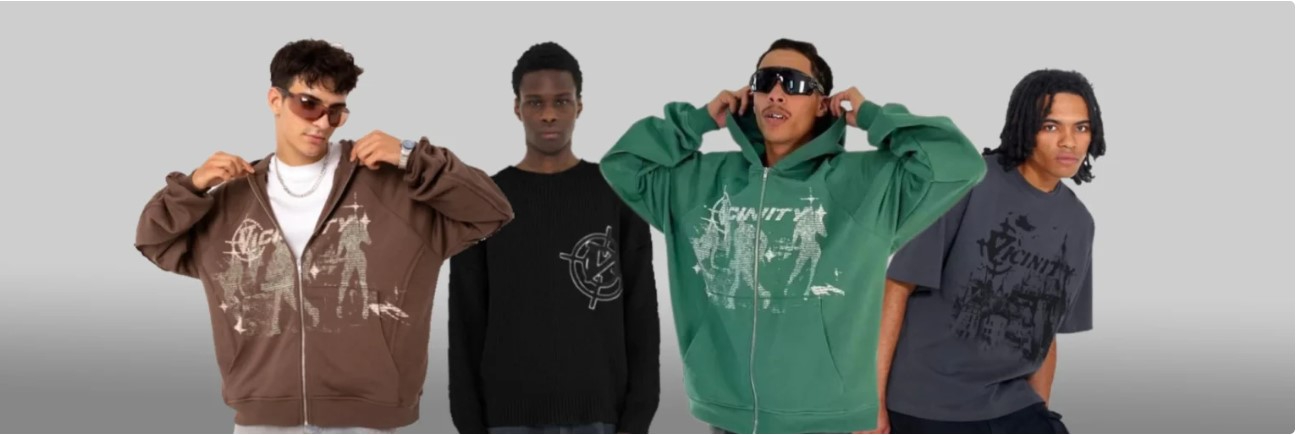In the ever-evolving world of mold, the concept of “Vicinity” has picked up unmistakable quality, reflecting a move towards maintainable, nearby, and community-centered mold choices. This development is characterized by a center on locally sourced materials, territorial craftsmanship, and a commitment to moral hones. Region clothing is not fair almost fashion; it’s around interfacing with nearby culture, supporting little businesses, and making mold choices that emphatically affect the environment. This article dives into the quintessence of region clothing, investigating its roots, benefits, and affect on the mold industry.
Understanding Vicinity
At its center, Vicinity clothing alludes to articles of clothing that are planned, delivered, and sold inside a particular neighborhood region. It grasps the thought that mold can be both a la mode and feasible when it remains closer to domestic. This development empowers shoppers to prioritize neighborhood brands over mass-produced, all inclusive transported attire. It’s a response to quick design, which has overwhelmed the industry for decades, advancing cheap, expendable clothing that regularly comes with covered up social and natural costs.
The thought behind Vicinity clothing is to celebrate neighborhood assets, abilities, and inventiveness. It taps into territorial craftsmanship, conventional strategies, and materials that are local to an region, subsequently making pieces of clothing that carry a sense of put and personality. Region clothing can incorporate everything from locally made denim in the Joined together States, to hand-woven textures in India, or artisanal calfskin merchandise from Italy. This localization brings a one of a kind energy to each piece, making it a celebration of culture and tradition.
The Roots of the Movement
The rise of Vicinity Schuhe clothing can be followed back to a developing mindfulness of the natural and social impacts of the worldwide mold industry. As shoppers have gotten to be more cognizant of their carbon impressions, the request for clothing that adjusts with economical and moral values has surged. Numerous individuals are presently looking for options to quick design, looking for ways to decrease squander and bolster neighborhood economies.
Vicinity, clothing generation was a nearby undertaking. Tailors, needle workers, and weavers given communities with pieces of clothing made from nearby filaments and textures. In any case, with the rise of industrialization and globalization, generation moved abroad to nations with lower labor costs, driving to a surge in reasonable clothing alternatives. This move changed design into a globalized industry, but at a critical cost—both to the environment and to the specialists included in article of clothing production.
In reaction to this, numerous fashion-conscious shoppers have turned back to territory as a implies of countering the negative impacts of mass generation. This has started a resurgence in neighborhood brands, nearby artisans, and small-scale producers who center on making high-quality pieces of clothing with a lower natural affect. Region clothing offers a advanced bend on conventional hones, bringing back a sense of community and straightforwardness in the mold world.
The Benefits of Vicinity Clothing
- Natural Sustainability
One of the most critical focal points of region clothing is its commitment to natural supportability. The design industry is known for its significant carbon impression, due to a great extent to the transportation of crude materials and wrapped up products over the globe. By keeping generation nearby, region clothing decreases the carbon outflows related with long-distance shipping and minimizes the require for over the top packaging.
Moreover, neighborhood generation frequently goes hand in hand with maintainable hones such as the utilize of natural or reused materials and ecologically neighborly coloring forms. Artisans and small-scale makers are more likely to utilize conventional, low-impact strategies, which can essentially diminish contamination and squander. In differentiate, large-scale fabricating offices frequently prioritize speed and volume over eco-friendly hones, driving to significant natural harm.
- Supporting Nearby Economies
When buyers select region clothing, they are specifically supporting neighborhood businesses and artisans. This has a swell impact on the neighborhood economy, making occupations, cultivating inventiveness, and empowering enterprise. Nearby design brands regularly collaborate with adjacent providers, making a organize of little businesses that advantage from each other’s victory. This makes a difference to keep cash circulating inside the community, or maybe than streaming to expansive multinational corporations.
Additionally, region clothing advances reasonable compensation and way better working conditions for those included in the generation handle. When design is delivered locally, it is simpler to guarantee that specialists are treated decently and that labor hones follow to moral guidelines. This stands in stark differentiate to the sweatshop conditions regularly related with mass-produced articles of clothing in certain parts of the world.
- Social Association and Authenticity
Vicinity clothing permits for a more profound association to culture and convention, as it regularly joins territorial aesthetics, materials, and craftsmanship. Wearing clothing made by neighborhood artisans implies wearing pieces that reflect the history, imaginativeness, and soul of a put. It can be an opportunity to celebrate and protect social legacy through fashion.
This association to nearby personality too gives region clothing a sense of genuineness that is difficult to discover in mass-produced mold. Each piece tells a story—not fair of the designer’s vision but too of the community and culture that motivated it. For shoppers, this can be a significant way to express singularity and adjust with values that prioritize convention, genuineness, and a sense of place.
The Challenges of Vicinity Clothing
While the benefits of Vicinity clothing are various, it is not without its challenges. One of the essential obstacles is fetched. Locally delivered articles of clothing are frequently more costly than mass-produced choices, as they are made with higher quality materials and include more labor-intensive forms. For numerous buyers, the cost distinction can be a boundary, particularly in a showcase immersed with cheap, quick mold options.
Additionally, the scale of generation is intrinsically littler in Vicinity clothing, which can make it troublesome for nearby brands to compete with huge worldwide retailers in terms of assortment and accessibility. In any case, this littler scale is moreover what permits these brands to center on quality and uniqueness. Numerous advocates of region clothing contend that the higher cost is a reasonable trade-off for a article of clothing that endures longer and has a positive social and natural impact.
Educating shoppers approximately the genuine costs of their design choices is another challenge. The appeal of moo costs can eclipse the covered up costs of quick mold, such as destitute labor hones and natural debasement. To overcome this, neighborhood brands and advocates of region clothing must lock in in narrating and straightforwardness, making a difference buyers get it the esteem of their buys past the cost tag.
The Future of Vicinity Clothing
The future of Vicinity clothing looks promising, as more individuals are getting to be mindful of the require for alter in the mold industry. The COVID-19 widespread, for illustration, highlighted the vulnerabilities of worldwide supply chains and strengthened the esteem of neighborhood versatility. Amid this period, numerous customers turned to neighborhood businesses for their needs, counting clothing, starting a recharged intrigued in community-focused fashion.
Moreover, the rise of social media has made it simpler for little brands to reach a worldwide group of onlookers whereas keeping up a neighborhood personality. Stages like Instagram and TikTok permit nearby originators to exhibit their manifestations, construct a steadfast client base, and share the stories behind their pieces. This advanced nearness empowers region clothing brands to scale their reach without losing their center values of region and sustainability.
As the development develops, region clothing seem play a key part in reshaping the mold industry into one that is more capable, moral, and comprehensive. It speaks to a move towards slower, more keen utilization, where the accentuation is on quality, craftsmanship, and community or maybe than transitory trends.
Conclusion
Vicinity clothing epitomizes a reviving approach to mold that is established in community, maintainability, and genuineness. It challenges the status quo of quick mold by emphasizing the significance of neighborhood generation and moral hones. Whereas the development faces challenges, such as higher costs and the require for shopper instruction, its potential to change the industry is undeniable.
For those who esteem quality over amount, and who wish to make a positive affect with their mold choices, region clothing offers a compelling elective. It permits customers to grasp their nearby culture, back little businesses, and contribute to a more feasible future—one piece of clothing at a time. As mindfulness of its benefits proceeds to develop, region clothing is set to ended up a foundation of the mold industry’s travel towards a more dependable and excellent future.










